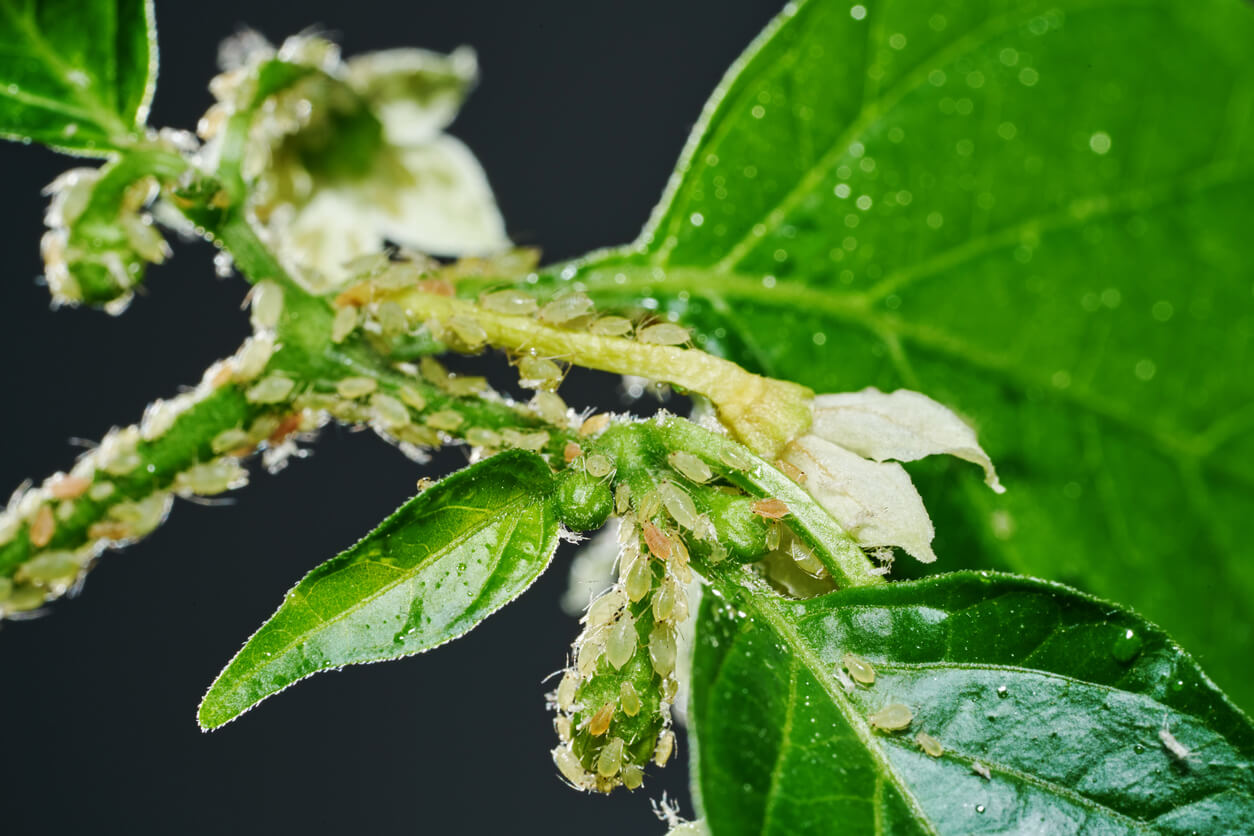When summertime works its magic on our favorite flowering shrubs, we aren’t the only ones thrilled to see the array of colorful blooms. Bugs are just as excited and can’t wait to feast upon Nature’s eye candy.
There are several types of insects that attack Central Florida’s flowering shrubs, and these pests seem to be getting more numerous with each passing year. Therefore, it’s important to get ahead of them by learning how to protect your prized landscape plants before they fall victim to serious damage.
While there are ways of getting rid of these persistent pests, the first step is learning how to deter them.
Garden Maintenance Matters!

Keeping a healthy landscape is the first line of defense against destructive insects. When plants are stressed, they emit pheromones that attract insects. Once the bugs locate the suffering shrub, the healthy specimens nearby will also be attacked.
Choose shrubs that are well suited to the areas you have planned for them. Before planting, determine if the spot will allow the shrub to receive adequate sunlight and air circulation even after it reaches its maximum size.
Water according to the weather conditions. When your area is expecting showers, pause your irrigation system for the day. During droughts, keep your sprinklers locked and loaded. When shrubs get too much or too little water, they become weak, which will make them more vulnerable to insects. Watering too much creates the wet environment bugs are attracted to and causes root rot to set in. This is a bad combination. If the shrub suffers an infestation and root damage at the same time, it may not be strong enough to heal from all the damage. On the flip side, watering too little causes wilt that attracts suckling insects. This is a perfect storm scenario that will quickly exhaust shrubs of all moisture.
Morning showers are so refreshing! Irrigating in the early AM gives shrubs the moisture they need to endure the daylong heat. Furthermore, giving ornamentals a drink in the morning is a great way to prevent water from accumulating on and around them, so bugs are less likely to set up shop. Never irrigate during the hottest hours of the day. Doing this can scorch the shrub’s leaves, which will weaken it and cause it to become more vulnerable to insects and the damage they inflict.

Speaking of irrigation, it’s good practice to monitor your irrigation system on a regular basis to make sure it’s turning on and shutting off in accordance with the settings. If you’re not sure your system is running like it should, call us or complete our request service form and we’ll come take a look.
Feed them an ideal meal. Providing shrubs with the right amount of fertilizer gives them the strength they need to fend off pests and environmental stressors. Keeping ornamentals well fed also enables them to quickly recover when they suffer damage.
Learn to Identify and Defend Against Hostile Invaders.
Sri Lanka Weevils – These white and gray insects are about ¼ of an inch long. They have two antennae on their heads and black eyes. Adults can cause severe damage to the foliage and the larvae feed on the roots, which inhibits the shrub’s growth and can lead to its death.
Insecticides work well to control adult weevils, but this won’t kill the eggs, so you’ll have to retreat the shrub until you no longer see any more of these unwelcome visitors.
Aphids – These are tiny, pear-shaped bugs about an 1/8 of an inch long. Species can differ in color, but the ones found in Florida are black, green, or yellow. While they will attack all plants, they are most attracted to new growth and prefer low-light conditions. Aphids are especially destructive because they suck juices from the leaves, which causes them to curl and inhibits the overall growth of the plant. To make matters worse, aphid larvae inflict significant damage by feasting on the roots. Aphids are prolific breeders that can produce 50 to 100 offspring that are capable of reproducing in just six to eight days.

The good news is that aphids can be controlled through natural means. The easiest way is to use a hose to knock them off the shrub with a strong stream of water. Another way is to plant dill, oregano, yarrow, or coriander to attract ladybugs who love to chow down on them. Growing garlic, onions, and chives will deter aphids. Neem oil and horticultural oil can get rid of aphids, but these treatments will also kill beneficial insects, so only use this method for infestations.
Soft Scales – Florida is home to ten species of scale, which range in size from an 1/8 of an inch to a 1/4 of an inch. Some species of females can even reproduce without the assistance of males.
These suckling pests are a great danger to ornamentals. Not only can they tap a shrub dry, but they also secrete a sticky substance called honeydew that attracts mold and mildew.
To rid your shrub of these sticky suckers, inspect the entire plant and remove any visible scale by wiping it off the leaves and stems with a wet paper towel, or you can scrape it off with your fingernail or a toothpick. If any parts of the plant are severely infested, you may need to snip off these sections. Next, rinse off the affected areas with warm water paying special attention to the underside of leaves. Never hose the shrub down with cold water or it could go into shock. Once the ornamental dries, saturate the shrub with insecticidal soap. Adding a systemic insecticide to the soil helps keep the scale at bay. A week after spraying it down with insecticidal soap, treat the shrub again in the same manner. Finally, keep an eye on the stems and leaves to make sure the scale doesn’t reemerge.
Mealybugs – These soft-bodied pests are about an 1/8 of an inch long. Their bodies are a shade of pink or yellow and often covered with white filaments. They are attracted to warm, humid areas. They have specialized mouths that allow them to puncture the plant, so they can enjoy sucking out its juices.

There are a few ways to rid your ornamentals of these nasty sapsuckers. First, wash the shrub down with a forceful jet of water. Next, wipe the remaining bugs with a cloth soaked in isopropyl alcohol. This will kill them on contact. Follow up these treatments by spraying the shrub with insecticidal soap until it’s dripping wet. Once you’ve done all these steps, keep a careful watch on your shrubs. If you see more of these bugs, retreat the ornamentals in the same manner. In a final word of caution, be careful about over fertilizing your plants because the excess nutrients will attract these fuzzy-looking bugs and put them in the mood to multiply.
Repel Bad Insects with Good Husbandry.
Finding killer pests munching on your gorgeous ornamental shrubs can be so frustrating. However, when you do what’s necessary to grow healthy specimens, battling bugs will feel like a walk in the park. Practicing proper irrigation and fertilization standards is key. Once this is mastered, you won’t have to go into full battle mode because you have happy shrubs living in an environment that insects are unable to thrive in.
Remember, if you ever need assistance with sprinkler repair or irrigation in the Orlando area, give us a call!

